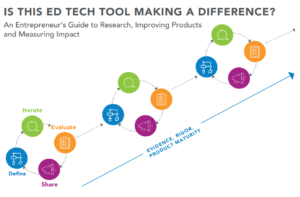Research is a critical component of how we do our work at NewSchools Venture Fund. In fact, we have a motto: “Share what you learn as fast as you learn it.” We believe this is useful for informing our investment strategy, and also for supporting the work of others in the field.
One of our three investment areas is ed tech. Like other innovators, ed tech entrepreneurs value research. However, especially in the early stages of product development, they are constantly refining their products to make them easier to use and more effective. Given this process, it’s not feasible to freeze product development and wait months, even years, for a traditional efficacy study.
Yet, there is still tremendous value in observing and sharing what they are learning while making changes along the way. This can provide valuable insights into how well products are working, for which students, under which conditions. Because the companies and nonprofits we support are led by people who care deeply about learning outcomes, we’ve been wrestling with this conundrum together. To help address this issue, we’re creating a framework for ed tech research.
“Is this Ed Tech Tool Making a Difference? An Entrepreneur’s Guide to Research, Improving Products and Measuring Impact” will be released later this summer. It will explore different types of ed tech research, noting those that are appropriate at various stages of product development, on small or large budgets, and within varying timeframes. We believe this guide will be useful to ed tech entrepreneurs, and it will also offer important insights for funders and educators.
For ed tech product developers, we have outlined four key steps in our framework:
- Define the intended impact and create a logic model. Identify student outcomes you believe your product will support, and get feedback on the logic model from a diverse group of stakeholders.
- Iterate. Test feasibility of your product and conduct usability testing. Observe how the product is used by real teachers and students, and refine use cases.
- Evaluate. Collect evidence of student outcomes. Define study parameters within the range of affordable costs at the current stage, mindful of ROI.
- Share what you learn about impact with your key audiences (like teachers, investors, etc.). Synthesize evidence to communicate how your product is impacting student outcomes.
The most important point we want to make is that many types of research have value. Whether it is a small-scale trial with users, or a randomized controlled trial, or any of the many options that fall in between, there is something to be learned from it. Equally important, the entrepreneur’s journey is not linear. The steps don’t fall perfectly into a sequential order, and each step along the journey has value as an independent undertaking.
We look forward to sharing the full framework, but thought it would be useful to share our thoughts so far. Because, as we said earlier…at NewSchools, we like to share what we learn as fast as we learn it. So, check out the graphic included in this post, and stay tuned for more.



